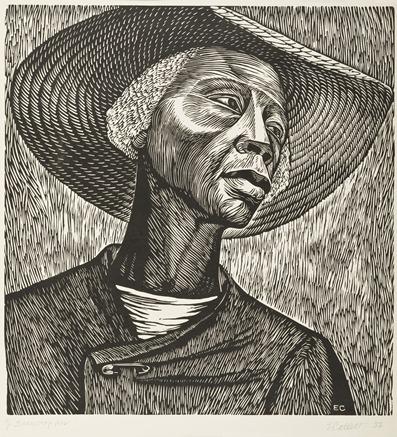Last month the newly formed American Art Acquisitions Group voted to acquire Elizabeth Catlett’s Sharecropper, a graphic masterpiece. A sophisticated and virtuosic pattern of cuts into the linoleum block create the striking energy and clarity of this print.
Catlett, who is the granddaughter of slaves and just celebrated her 96th birthday in April, was first introduced to the linoleum cut, or linocut, in 1946, when she apprenticed at El Taller de Gráfica Popular in Mexico City (The People’s Graphic Workshop). The artists’ collective (Catlett was a member from 1946 to 1966) influenced her commitment to create art that would promote social change and be accessible to broad audiences. Prints, in particular linocuts, were the workshop’s specialty and became Catlett’s preferred medium: they were inexpensive, easy to incise, and conducive to publishing large editions. The linocut is also aesthetically appealing for its smooth, uniform, and clean surface qualities. Sharecropper, first created in 1952, is one of Catlett’s most iconic works, and the version just acquired for LACMA is the artist’s proof—the first impression pulled by the artist. The vivid contrasts of the black and white markings creating the sharecropper’s weathered skin, textured white hair, and broad brimmed straw hat framing her face are direct and vigorous—and contrast with fatigue evident in the eyes and the large safety pin neatly holding her lightweight jacket closed. These details allude to hardships of the life of a sharecropper. Sharecropping was an agricultural system that emerged in the U.S. immediately following the Civil War. Laborers worked plantation lands, usually cotton fields, in exchange for a portion of the crops, but typically the proceeds from the crops were allocated to the landowners in advance for expenses, such as housing on the plantation, now required of the farmers. For formerly enslaved African Americans, this exploitative system created extensive and ongoing disenfranchisement. Catlett’s image does not shy from this history, nor have other artists throughout the history of American art since Reconstruction. In fact, Sharecropper demonstrates the persistence of this theme, namely picking cotton, in American art for both African American and Caucasian artists, including, from LACMA’s collection, Winslow Homer (The Cotton Pickers, 1876), Thomas Hart Benton (Cotton Pickers, 1931), and John Biggers (Cotton Pickers, 1947). However, Catlett’s Sharecropper is now the American art collection’s most modern image of American sharecroppers, and one of the artist’s innovations was to remove any visual reference to the cotton field or bags. As a result the image appears more universal and heroic, a portrait of the everywoman sharecropper to whom we look up but who does not meet our gaze. Sharecropper in on view now in our American art galleries.



